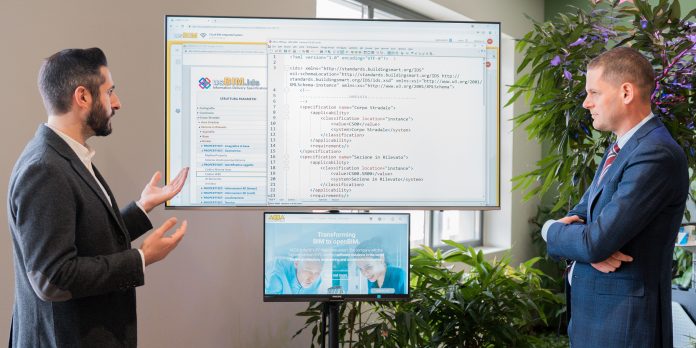In March, ACCA Software had the great honour to host the buildingSMART International delegation from the prestigious worldwide organisation that has been leading the digital transformation of the construction sector since 1994
During their visit, Michelangelo Cianciulli, one of the world’s leading experts in openBIM, presented some applications of ACCA’s technology in openBIM workflows to the bSI technical director Léon Van Berlo.
An interesting meeting which turned out to be a great occasion to showcase ACCA’s activities in pursuing innovation in the world of BIM and openBIM.
It was also an opportunity to highlight how the use of openBIM standards and workflows can bring enormous benefits to all stakeholders. By adopting technical applications, tools and services developed for openBIM, the use of BIM methodologies can be extended in many different fields of application improving the management of any kind of project.
OpenBIM standards: What are they and what are the main advantages deriving from their use?
OpenBIM standards are open data standards which are not controlled by individual suppliers while promoting interoperability between construction disciplines and different stakeholders.
The main openBIM standards are:
- Data standards.
- Workflow standards.
- OpenBIM services.
Data standards
The complexity of modern construction projects requires the use of open standards.
A single project can involve hundreds of stakeholders, from the architect to the contractor, each of whom must contribute and seamlessly access such data throughout the building or infrastructure’s lifecycle. Open standards allow us to go beyond the limits of proprietary formats linked to interoperability, making communication and collaboration between all parties involved in the project streamlined and more efficient.
The following belong to the data standard:
- IFC (Industry Foundation Classes) is a standardised, digital description of the built environment, including buildings and civil infrastructures.
- MDV (Model View Definition) defines which of these data descriptions need to be exchanged during a communication process and represents a property filter for an IFC file.
Workflow standards
In a BIM process, there are different disciplines and specific models created by different professionals who need to communicate and collaborate by exchanging data, models and documents. In order for there to be efficient workflows and coordinated activities, standard workflows must be defined, such as a set of specifications that indicate the information necessary to achieve each process that makes up the building’s lifecycle.
Standard workflows include:
- BCF (BIM Collaboration Format): Allows professionals to communicate coordination information, streamline communications and exchange feedback between professionals. This particular format contains problem descriptions, snapshots, comments, authors, the issue date without containing any geometry of elements of the model itself.
- Information Delivery Manual (IDM): Allows you to standardise the flow of construction processes by identifying the information required by this flow, the form in which the information should be specified and an appropriate way to map and describe information processes within a construction lifecycle.
- Information Delivery Specification (IDS): Defines the Exchange Requirement within an exchange of information based on the use of a BIM model.
OpenBIM services
Among other openBIM services, we also find the bSDD (buildingSMART Data Dictionary), an online bSI service created to map technical data in a standard manner.
The bSDD is a service that hosts national classifications (Uniclass, MINnD, etc), application-specific standards (ETIM, UniversalTypes, IfcAirport, etc), national and company-specific standards, dictionaries and their properties, permitted values, units and translations.
The bSDD is an “API-first” service. End users can access it through software tools that have implemented the bSDD API. With these tools, IFC models are enriched with all the information contained in the bsDD to create standardised workflows of the highest quality. The advantages of this operating method are not only for designers, builders but also for manufacturers, suppliers and end users who can access definitions, classifications and object libraries in a shared, reusable and above all constantly available ecosystem for all software solutions.
The “easy BIM for everyone” with ACCA software solutions
“BIM is either for everyone or it can’t exist at all! […] In construction, there are many data users, each one has its own problems or interests but everyone has to be able to access the construction information system without any technological or economic barriers,” said Antonio Cianciulli, CMO-CCO of ACCA.
With this in mind and with the aim of enjoying the advantages of openBIM, not only engineers and architects but also customers and end users can all benefit from ACCA’s developments:
- usBIM, a BIM management system for the management of BIM processes and 100% openBIM workflows.
- usBIM.bSDD, one of the first solutions based on the buildingSMART Data Dictionary that allows you to classify the elements of a BIM model in IFC format according to the bSDD standard.
Certainly, one of ACCA’s strong points of their solutions is simplicity, as Léon van Berlo (bSI Technical Director) also pointed out: “It’s really nice to see how you make such complex topics so easy for end users. I think that’s why it’s so exciting to visit ACCA’s offices. There is a lot of advanced technology but presented in a very simple way for end users.”
Tel: +44 2038683191
*Please note: this is a commercial profile














